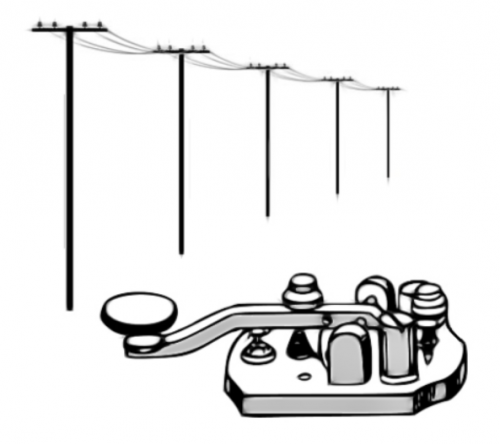Electrical Telegraph
An Electrical Telegraph is a point-to-point messaging system, using electrical currents carried by conductive wires across vast distances.
- It is a technological device.
- It is a type of communications equipment.
- It is a type of Telegraph that uses an electrical system.
Description (Specifications)[edit]
An electrical telegraph is a type of communications equipment used for signalling using a series of electrically generated audible tones.
- Signals are carried by a network of conductive wires.
- It is in common usage by TL–4.
- It requires an electrical charge in order to make it work (stored within a battery or created by turning a generator handle).
- It requires appropriate transmitter / receiver equipment to use it.
It is a contemporary of the Mechanical Telegraph
Image Repository[edit]
Key elements of an electrical telegraph system.

Function[edit]
An electrical telegraph most commonly takes the form of a series of poles with conducting wires strung between them.
- The wires cross vast distances and may be thousands of kilometers long.
- The wires connect distant regions of the surface of a world and allow instantaneous communication between them.
- These wires can be connected directly to a transmitter / receiver, allowing direct communications.
- It is common to use long tones and short tones (dots and dashes) as the structure for messages. Each set of tones corresponds to a letter, number, or phrase.
- The tones are generated by the operator closing a circuit by pushing a button or lever on their transmitter / receiver.
Crew[edit]
A skilled individual with the correct transmitter / receiver equipment can link into an electrical telegraph system.
- Operators use portable receiver / transmitter units to communicate.
- Technicians constantly maintain and repair the systems infrastructure of wires.
Limitations[edit]
The electrical telegraph relies on a continuous length of conductive wire running between locations. The wires are fragile and easily damaged: a break in a wire severs communications.
- Wires are prone to the effects of the environment (such as wind and wind-borne debris, water damage, lightning strikes, or animal activity).
- They are easy to deliberately damage.
Wires meet at an Exchange, a hub where specially trained operators are able to connect or isolate different parts of the network.
Telegraph wires often follow existing transportation routes.
- The wires provide an important communication service to travellers along the route.
- Damage to the wires is easier for technicians to locate and repair.
History & Background (Dossier)[edit]
Electrical Telegraph technology is first available at TL–3
- An electrical telegraph is a refinement of earlier technology but reaches its apex at TL–4. It uses complex machined components to precisely control signalling devices in order to transmit large volumes of data quickly and efficiently.
- Electrical telegraph systems are superseded by other technological advances, such as telephones and radios at TL-5, and electronic equipment by TL-6.
Electrical Telegraphs are commonly used by the military and by government agencies to convey orders, messages, and instructions over long distances.
- Law enforcement routinely use telegraphs.
- Banks and other commercial institutions regularly utilize telegraphs.
- Electrical telegraphs often carry important items of news.
- Messages may be sent by private individuals for a small fee.
Coding and Security[edit]
Very few messages are sent in plain text. Most words and phrases are abbreviated and codes and cyphers are routinely employed.
Basic images may be transmitted using electrical telegraph systems - long tones denote a dark spot and short tones denote a light area. These can be used to create a simple dot matrix picture.
References & Contributors (Sources)[edit]
- Author & Contributor: Lord (Marquis) and Master Scout Emeritus Adie Alegoric Stewart of the IISS
